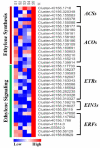Comparative Transcriptome Analysis of Flower Senescence of Camellia lutchuensis
- PMID: 35814935
- PMCID: PMC9199534
- DOI: 10.2174/1389202923666220203104340
Comparative Transcriptome Analysis of Flower Senescence of Camellia lutchuensis
Abstract
Background: Flower senescence is the last stage of flower development and affects the ornamental and economic value of flower plants. There is still less known on flower senescence of the ornamental plant Camellia lutchuensis, a precious species of Camellia with significant commercial application value.
Methods: Transcriptome sequencing was used to investigate the flower senescence in five developmental stages of C. lutchuensis.
Results: By Illumina HiSeq sequencing, we generated approximately 101.16 Gb clean data and 46649 differentially expressed unigenes. Based on the different expression pattern, differentially expressed unigenes were classified into 10 Sub Class. And Sub Class 9 including 8252 unigenes, was highly expressed in the flower senescent stage, suggesting it had a potential regulatory relationship of flower senescence. First, we found that ethylene biosynthesis genes ACSs, ACOs, receptor ETR genes and signaling genes EINs, ERFs all upregulated during flower senescence, suggesting ethylene might play a key role in the flower senescence of C. lutchuensis. Furthermore, reactive oxygen species (ROS) production related genes peroxidase (POD), lipase (LIP), polyphenoloxidase (PPO), and ROS scavenging related genes glutathione S-transferase (GST), glutathione reductase (GR) and superoxide dismutase (SOD) were induced in senescent stage, suggesting ROS might be involved in the flower senescence. Besides, the expression of monoterpenoid and isoflavonoid biosynthesis genes, transcription factors (WRKY, NAC, MYB and C2H2 ), senescence-associated gene SAG20 also were increased during flower senescence.
Conclusion: In C. lutchuensis, ethylene pathway might be the key to regulate flower senescence, and ROS signal might play a role in the flower senescence.
Keywords: Camellia lutchuensis; differentially expressed genes; ethylene; flower senescence; reactive oxygen species; transcriptome.
© 2022 Bentham Science Publishers.
Figures




Similar articles
-
De novo transcriptome analysis of petal senescence in Gardenia jasminoides Ellis.BMC Genomics. 2014 Jul 4;15(1):554. doi: 10.1186/1471-2164-15-554. BMC Genomics. 2014. PMID: 24993183 Free PMC article.
-
Transcriptome analysis of Rafflesia cantleyi flower stages reveals insights into the regulation of senescence.Sci Rep. 2021 Dec 8;11(1):23661. doi: 10.1038/s41598-021-03028-x. Sci Rep. 2021. PMID: 34880337 Free PMC article.
-
Molecular aspects of flower senescence and strategies to improve flower longevity.Breed Sci. 2018 Jan;68(1):99-108. doi: 10.1270/jsbbs.17081. Epub 2018 Feb 27. Breed Sci. 2018. PMID: 29681752 Free PMC article. Review.
-
Genome and transcriptome-based characterization of high energy carbon-ion beam irradiation induced delayed flower senescence mutant in Lotus japonicus.BMC Plant Biol. 2021 Nov 3;21(1):510. doi: 10.1186/s12870-021-03283-0. BMC Plant Biol. 2021. PMID: 34732128 Free PMC article.
-
Flower senescence: some molecular aspects.Planta. 2014 Feb;239(2):277-97. doi: 10.1007/s00425-013-1984-z. Epub 2013 Nov 1. Planta. 2014. PMID: 24178586 Review.
Cited by
-
Ethylene Activates the EIN2-EIN3/EIL1 Signaling Pathway in Tapetum and Disturbs Anther Development in Arabidopsis.Cells. 2022 Oct 10;11(19):3177. doi: 10.3390/cells11193177. Cells. 2022. PMID: 36231139 Free PMC article.
References
-
- Yang C.P., Xia Z.Q., Hu J., Zhuang Y.F., Pan Y.W., Liu J.P. Transcriptome analysis of Oncidium petals provides new insights into the initiation of petal senescence. J. Hortic. Sci. Biotechnol. 2018;94(1):12–23. doi: 10.1080/14620316.2018.1432297. - DOI
-
- Skutnik E., Łukaszewska A., Rabiza-Świder J. Effects of postharvest treatments with nanosilver on senescence of cut lisianthus (Eustoma grandiflorum (Raf.) Shinn.) flowers. Agronomy (Basel) 2021;11(2):215. doi: 10.3390/agronomy11020215. - DOI
LinkOut - more resources
Full Text Sources
Research Materials
